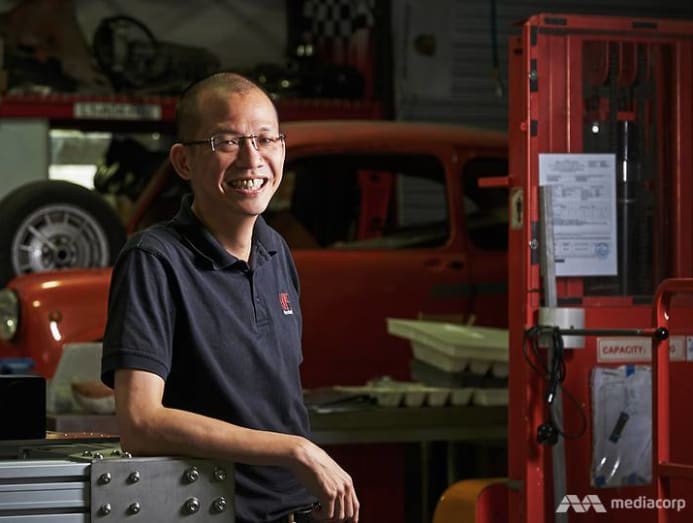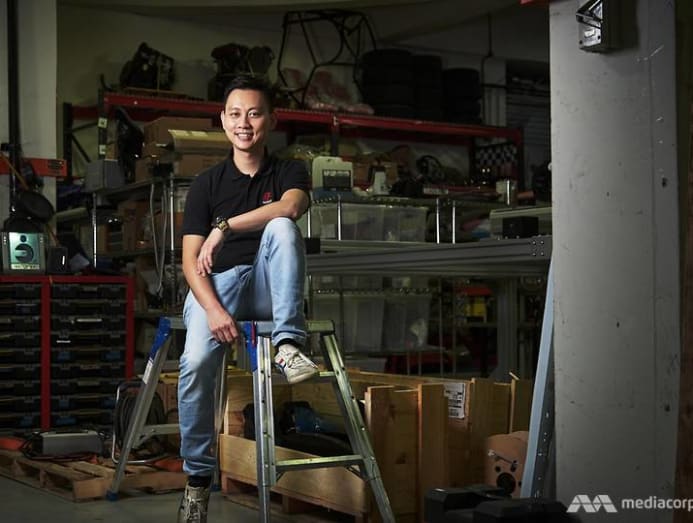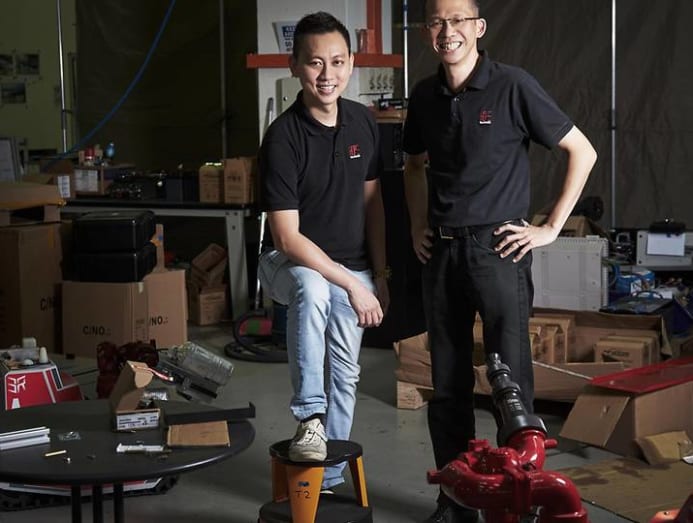How a former motorsport mechanic's assistant built a multimillion-dollar engineering firm
At the height of his scramble-or-sideslip career in motorsports engineering, Peter Ho saw his plans become upwards in acrid, eddying smoke. It was the evening before his first qualifying race as chief engineer of Team Petronas' Touring Cars, and before their title sponsor at Sepang International Excursion, that his team'due south vehicle caught fire due to a mishap.
"The get-go half of the car was burnt to a crisp, even the rims had melted; it was quite legendary," he recounted, with a dash of levity. Fuelled by a paroxysm of panic, what followed were some xiv hours of frenetic activity, as Ho commandeered an international team to successfully reconstruct the scorched car overnight.
Today, out of the soot-daubed paddocks and strapped into the driver's seat as CEO and co-founder of multimillion-dollar engineering firm Hope Technik, the 42-yr-old reflects upon his decade-long stint in motorsports as having a seminal influence on his entrepreneurial path. "Under tremendous force per unit area, I saw the ability of many when anybody works together and does the chore they are all-time suited for," he mused.
The son of a pest control man of affairs and homemaker proclaims that he plumped for his time to come profession at the historic period of v. "I had built a Lego contraption that resembled my mother's fake Singer, and my Dad told me that I would accept to get a mechanical engineer to create a real sewing automobile," he recounted.
As an incipient engineer, he indulged his technical bent by cranking out robots for school science projects, and dismantling a veritable disassembly line of household appliances. "Zip at home was safe; if the water heater couldn't work, 11-year-erstwhile me would accept removed information technology from the wall and ripped information technology autonomously in the sleeping room," he shared.
WATCH> Why did this former engineer-turned-leather craftsman take autonomously Hermes bags?
The gangly and animated mechanical technology graduate plays the function of the zany inventor convincingly. Exuberantly greeting me at Hope Technik'due south lobby – anomalous for a CEO – he reveals that the precariously inclined steel slide linking the 2d and ground floors was built on a lark to examination his engineers' welding skills.
The self-proclaimed "happily married begetter of ii cats" betrays a proclivity for jokes referencing his baldness, and committed Dr Evil impressions. Though he no longer builds machines (there'southward a running joke in the function that his engineering skills leave much to be desired), he all the same tinkers with vintage automobiles. Prized possessions include a 1960s Lotus Seven formerly endemic by his late boss, though I'm told he hasn't fabricated much progress on it.
Yet, for all his quirks, Ho is adamant that his team's efforts should have centrestage. These are not limited to feats such equally an aircraft built for aerospace giant Airbus Defence and Space to navigate the outer limits of space; defence equipment for countries beyond Asia, and most recently – a contactless temperature self-cheque kiosk deployed in MRT stations and other locations beyond Singapore and the region.
"Under tremendous pressure level, I saw the power of many when everyone works together and does the job they are best suited for." – Peter Ho
THE Hereafter IS Here

Founded past Ho and his National University of Singapore (NUS) schoolmates Michael Leong, Ng Kiang Loong and Jeff Tang in 2006, Promise Technik has since delivered more than 500 projects across 20 countries.
But how did a 4-man outfit ascent from virtual obscurity to clinch plum regime contracts including one that entailed improving Singapore Ceremonious Defense's (SCDF) iconic Red Rhino firefighting vehicle?
Co-ordinate to the petrolhead, the co-founders – who accept all represented NUS in Formula SAE, an international race car design competition for students – rode on their competitive edge.
"In professional motorsports, I accept two weeks to brand my race motorcar faster than the last idiot who beat me. We merely took that spirit and started with small contracts, delivering better results than others," he shared.
Sequestered in a tiny workshop without the right tools, the friends ratcheted up credibility by accepting a raft of performance-based contracts to build drones and robotic systems.
"We ran sliding scales with customers and bluntly speaking, our fees seemed like they were worked out with rounding errors. We were fortunate that we were able to become to extremes in producing lighter, faster and more fuel-efficient equipment," said the adjunct assistant professor at NUS' Faculty of Engineering.
This led to other projects that run the gamut from assistive exoskeletons to an autonomous marine craft and SCDF's Red Rhinoceros vehicle – of which they take adult five iterations. Ho shares that the company balances the interests of its competing public and individual sector clients past ensuring teams piece of work in strict silos. Underpinning their power to dial to a higher place their weight is a fundamental appreciation of engineering's ability to push button limits.
"If someone told u.s.a. to make a plane that tin can wing halfway around the world, we would probably say, if y'all have the coin, you'll get your plane," said Ho, though he claims unethical endeavours are verboten. When pressed, he maintains that they've declined requests from "interesting potential clients'" to create robots with a "scope not aligned to Hope Technik's' core values".
"If someone told united states of america to make a aeroplane that can fly halfway effectually the world, we would probably say, if you have the money, you'll get your plane." – Peter Ho
PARADIGM SHIFT

Prevarication aside, it's clear the self-made businessman has moxie. In his boyhood, he elbowed his way into Malaysia'south motorsports arena every bit an unpaid mechanic'southward assistant.
"It'south called child labour – you sleep on the floor of the hotel room and polish and clean cars for experience," he recalled. From his grease monkey days shunted to the back of the bus, to occupying the coveted chief engineer position, Ho jammed the brakes on his high-octane career due to its arduously itinerant lifestyle.
"Travelling weekly, I could be in Australia for a four-hour stint, or told I was to spend a calendar week there simply to return with a trolley bag nine months later on," he explained. Job security was another consideration, in an era laden with financial woes precipitated by the 2003 SARS epidemic.
"During an economic downturn, the first thing to go is corporate sponsorship for race cars that run round in circles really fast," he said. Hope Technik was built-in out of rejection, later Ho's job applications were dismissed by numerous firms. "Nosotros could as well have been called desperate engineering science," he quipped.
Every bit it turns out, the more than 100-homo strong company's active manoeuvres have proven that Ho'south leap of faith was no exercise in futility.
Hope Technik production possessor Daniel Nia shared that it took his team just four months to develop the recently adopted Temperature Assessment System (T.A.South), which underwent rigorous clinical trials to accomplish certification as a Class B medical device. This was in response to the Defence Science and Technology Bureau's call for a more than accurate and portable temperature scanner. "The device is being used in countries including Australia, Vietnam and Thailand. Surprisingly, we've had the most orders from Nihon," he said.
And while the give-and-take pin has – in the upheaval of COVID-19 – swivelled its way into our common lexicon, Ho contends the specialist firm hasn't exactly inverse its tack past producing the T.A.Southward in bulk. Among its concurrent projects is a robotics middleware framework for healthcare to facilitate smart system evolution, which will go live next year.
Innovation, the former GovTech board member asserts, is paramount. He believes that Promise Technik's success is partly attributed to its hands-off arroyo to staff management – plus a skilful measure of blasphemy.
"You can tell from the Tamiya tracks in our vestibule that we have the maturity of 9-year-olds. We operate this way considering when people have a vocalization and don't have to worry about outward appearances, they can concentrate on what they need to do," he stated.
Leaving the facility, I spot a lanky employee whizzing down the metallic slide, past a tangle of toy race tracks, to bring together his colleagues for the company town hall. It's apparent that these engineers have found their fraternity.

Source: https://cnalifestyle.channelnewsasia.com/people/peter-ho-hope-technik-singapore-engineer-246866
0 Response to "How a former motorsport mechanic's assistant built a multimillion-dollar engineering firm"
Enregistrer un commentaire